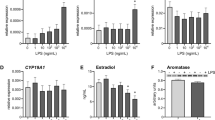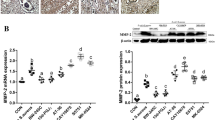Abstract
The increase in steroid hormone blood levels in response to bacterial lipopolysaccharide (LPS) appears to be an important mechanism by which mammalian species regulate inflammation. This study examined changes in serum concentrations of cortisol, progesterone, and 13,14-dihydro-15-keto-prostaglandin F2α (PGFM) in diestrous pigs following the intravenous injection of LPS and determined whether indomethacin would attenuate these changes. Serum cortisol and progesterone concentrations increased (P<0.05) within 30 min after the administration of LPS, and the increases in steroid hormones were accompanied by a sharp, transient increase (P<0.05) in PGFM levels. In the presence of indomethacin, serum PGFM levels did not change (P>0.05); however, LPS enhanced (P<0.05) cortisol and progesterone concentrations, although the increases were delayed. Serum concentrations of cortisol acutely increased (P<0.05) immediately following both infusions of indomethacin. In summary, cortisol and progesterone concentrations increased irrespective of serum PGFM concentrations, thereby indicating that prostaglandin F2α was not the sole mediator of LPS-induced changes in cortisol and progesterone concentrations.
Similar content being viewed by others

References
Culbertson, R., andB. I. Osburn. 1980. The biological effects of bacterial endotoxin: A short review.Vet. Sci. Commun. 4:3–14.
Michalek, S. M., R. N. Moore, J. R. McGhee, D. L. Rosenstreich, andS. E. Mergen-Hagen. 1980. The primary role of lymphoreticular cells in the mediation of host responses to bacterial endotoxin.J. Infect. Dis. 141:55–63.
Wright, S. D., R. A. Ramos, P. S. Tobias, R. J. Ulevitch, andJ. C. Mathison. 1990. CD14, a receptor for complexes of lipopolysaccharide (LPS) and LPS binding protein.Science.249:1431–1433.
Andersson, J., S. Nagy, L. Bjork, J. Abrams, S. Holm, andU. Andersson. 1992. Bacterial toxin-induced cytokine production studied at the single-cell level.Immunol. Rev. 127:69–96.
Nathan, C. F. 1987. Secretory products of macrophages.J. Clin. Invest. 79:319–326.
Olson, N. C., W. L. Salzer, andC. E. McCall. 1988. Part 2: Physiological aspects of endotoxemia.Mol. Aspects Med. 10:551–629.
Dinarello, C. A. 1991. The proinflammatory cytokines interleukin-1 and tumor necrosis factor and treatment of the septic shock syndrome.J. Infect. Dis. 163:1177–1184.
Wright, L. J., M. B. Lipsett, G. T. Ross, andS. M. Wolff. 1972. Effects of dexamethasone and aspirin on the responses to endotoxin in man.J. Clin. Endocrinol. 34:13–17.
Munck, A., P. M. Guyre, andN. J. Holbrook. 1984. Physiological functions of glucocorticoids in stress and their relation to pharmacological actions.Endocrinol. Rev. 5:25–44.
Gilbert, R. O., W. T. K. Bosu, andA. T. Peter. 1990. The effect ofEscherichia coli endotoxin on luteal function in Holstein heifers.Theriogenology.33:645–651.
Christeff, N., M. C. Auclair, C. Benassayag, A. Carli, andE. A. Nunez. 1987. Endotoxin-induced changes in sex steroid hormone levels in male rats.J. Steroid Biochem. 26:67–71.
Richards, R. G., G. W.Almond, and C. A.Smith. 1990. Effects of endotoxemia on steroid and luteinizing hormone concentrations in diestrous gilts. Program of the 11th International Pig Veterinary Society, 1–5 July 1990, at Lausanne, Switzerland. 434.
Stites, D. P., andP. K. Siiteri. 1983. Steroids as immunosuppressants in pregnancy.Immunol. Rev. 75:117–138.
Yasuda, N., andM. A. Greer. 1978. Evidence that the hypothalamus mediates endotoxin stimulation of adrenocorticotropic hormone secretion.Endocrinology.102:947–953.
Sapolsky, R., C. Rivier, G. Yamamoto, P. Plotsky, andW. Vale. 1987. Interleukin-1 stimulates the secretion of hypothalamic corticotropin-releasing factor.Science. 238:522–524.
Bernardini, R., T. C. Kamilaris, A. E. Calogero, E. O. Johnson, M. T. Gomez, P. W. Gold, andG. P. Chrousos. 1990. Interactions between tumor necrosis factor-α, hypothalamic corticotropin-releasing hormone, and adrenocorticotropin secretion in the rat.Endocrinology.126:2876–2881.
Navarra, P., S. Tsagarakis, M. S. Faria, L. H. Rees, G. M. Besser, andA. B. Grossman. 1990. Interleukins-1 and -6 stimulate the release of corticotropin-releasing hormone-41 from rat hypothalamus in vitro via the eicosanoid cyclooxygenase pathway.Endocrinology.128:37–44.
Hedge, G. A., andS. D. Hanson. 1972. The effects of prostaglandins on adrenocorticotropin secretion.Endocrinology.91:925–933.
Bernardini, R., A. Chiarenza, A. E. Calogero, P. W. Gold, andG. P. Chrousos. 1989. Arachidonic acid metabolites modulate rat hypothalamic corticotropin-releasing hormone secretion in vitro.Neuroendocrinology 50:708–715.
Sharp, B. M., andS. G. Matta. 1993. Prostaglandins mediate the adrenocorticotropin response to tumor necrosis factor in rats.Endocrinology 132:269–274.
Berghorn, K. A., L. A. Edgerton, G. L. Cromwell, andT. S. Stahly. 1989. Serum progesterone and luteinizing hormone following prostaglandin F2α during the sow's estrous cycle.Anim. Reprod. Sci. 19:273–282.
Gadsby, J. E., C. A. Smith, andG. W. Almond. 1991. Acute stimulatory effects of prostaglandin F2α on serum progesterone concentrations in pregnant and pseudopregnant pigs.Prostaglandins 41:419–432.
Mattioli, M., G. Galeati, A. Prandi, andE. Seren. 1985. Effect of PGF-2α on progesterone production in swine luteal cells at different stages of the luteal phase.Prostaglandin Leukotriene Med. 17:43–54.
Wiesak, T., M. G. Hunter, andG. R. Foxcroft. 1992. Effect of prostaglandins in luteal function during early pregnancy in pigs.J. Reprod. Fertil. 95:831–840.
Smith, C. A., andM. D. Ficken. 1991. Non-surgical cannulation of the vena cava for chronic blood collection in mature swine.Lab. Anim. Sci. 41:274–278.
Almond, G. W., andG. D. Dial. 1990. Steroid hormone and luteinizing hormone concentrations in the anestrous sow.Can. J. Vet. Res. 54:209–214.
Smith, C. A., G. W. Almond, andK. L. Esbenshade. 1992. Effects of exogenous estradiol-17β on luteinizing hormone, progesterone, and estradiol-17β concentrations before and after prostaglandin F2α-induced termination of pregnancy and pseudopregnancy in gilts.J. Anim. Sci. 70:518–524.
Peter, A. T., W. T. K. Bosu, andR. J. DeDecker. 1989. Suppression of preovulatory luteinizing hormone surges in heifers after intrauterine infusions ofEscherichia coli endotoxin.Am. J. Vet. Res. 50:368–373.
Massart-Leen, A. M., C. Burvenich, G. Vandeputte-Van Messom, andH. Hilderson. 1992. Partial prostaglandin-mediated mechanism controlling the release of cortisol in plasma after intravenous administration of endotoxins.Dom. Anim. Endocrinol. 9:273–283.
Santos, A. A., M. R. Scheltinga, E. L. Lynch, E. F. Brown, P. Lawton, E. Chambers, J. Browning, C. A. Dinarello, S. M. Wolff, andD. W. Wilmore. 1993. Elaboration of interleukin 1-receptor antagonist is not attenuated by glucocorticoids after endotoxin.Arch. Surg. 128:138–144.
Shuster, D. E., andR. J. Harmon. 1992. High cortisol concentrations and mediation of the hypogalactia during endotoxin-induced mastitis.J. Dairy Sci. 75:739–746.
Polan, M. L., A. Daniele, andA. Kuo. 1988. Gonadal steroids modulate human monocyte interleukin-1 activity.Fertil. Steril. 49:964–968.
Snyers, L., L. De Wit, andJ. Content. 1990. Glucocorticoid up-regulation of high-affinity interleukin 6 receptors on human epithelial cells.Proc. Natl. Acad. Sci. U.S.A. 87:2838–2842.
Hallford, D. M., R. P. Wettermann, E. J. Turman, andI. T. Omtvedt. 1975. Luteal function in gilts after prostaglandin F2α.J. Anim. Sci. 41:1706–1710.
Gadsby, J. E., A. K. Balapure, J. H. Britt, andT. A. Fitz. 1990. Prostaglandin F2α receptors on enzyme-dissociated pig luteal cells throughout the estrous cycle.Endocrinology 126:787–795.
Rampacek, G. B., R. R. Kraeling, E. S. Fonda, andC. R. Barb. 1984. Comparison of physiological indicators of chronic stress in confined and nonconfined gilts.J. Anim. Sci. 58:401–408.
Richards, R. G., andG. W. Almond. 1990. Endocrine changes associated with endotoxemia in diestrous gilts. Program of the 23rd Annual Meeting of the Society for the Study of Reproduction, 15–18 July 1990, at Knoxville, TN,Biol. Reprod. 42:108.
Kraeling, R. R., G. B. Rampacek, andT. E. Kiser. 1981. Corpus luteum function after indomethacin treatment during the estrous cycle and following hysterectomy in the gilt.Biol. Reprod. 25:511–518.
Spinedi, E., M. O. Suescun, R. Hadid, T. Daneva, andR. C. Gaillard. 1992. Effects of gonadectomy and sex hormone therapy on the endotoxin-stimulated hypothalamo-pituitary-adrenal axis: Evidence for a neuroendocrine-immunological sexual dimorphism.Endocrinology 131:2430–2436.
Michie, H. R., J. A. Majzoub, S. T. O'Dwyer, A. Revhaug, andD. W. Wilmore. 1990. Both cyclooxygenase-dependent and cyclooxygenase-independent pathways mediate the neuroendocrine response in humans.Surgery 108:254–261.
Akira, S., andT. Kishimoto. 1992. IL-6 and NF-IL6 in acute-phase response and viral infection.Immunol. Rev. 127:25–50.
Adashi, E. Y., C. E. Resnick, J. N. Packman, A. Hurwitz, andD. W. Payne. 1990. Cytokine-mediated regulation of ovarian function: Tumor necrosis factorα inhibits gonadotro-pin-supported progesterone accumulation by differentiating and luteinized murine granulosa cells.Am. J. Obstet. Gynecol. 162:889–899.
Benyo, D. F., andJ. L. Pate. 1992. Tumor necrosis factor-α alters bovine luteal cell synthetic capacity and viability.Endocrinology 130:854–860.
Pitzel, L. andW. Wuttke. 1993. Effects and interactions of prostaglandin F2α, oxytocin, and cytokines on steroidogenesis of porcine luteal cells.Endocrinology 132:751–756.
Tekpetey, F. R., H. Engelhardt, andD. T. Armstrong. 1993. Differential modulation of porcine theca, granulosa, and luteal cell steroidogenesis in vitro by tumor necrosis factor.Biol. Reprod. 48:936–943.
Rivier, C., andW. Vale. 1989. In the rat, interleukin-1α acts at the level of the brain and the gonads to interfere with gonadotropin and sex steroid secretion.Endocrinology 124:2105–2109.
Hume, D. A., D. Halpin, H. Charlton, andS. Gordon. 1984. The mononuclear phagocyte system of the mouse defined by immunohistochemical localization of antigen F4/80: Macrophages of endocrine organs.Proc. Natl. Acad. Sci. U.S.A. 81:4174–4177.
Adashi, E. Y. 1990. The potential relevance of cytokines to ovarian physiology: The emerging role of resident ovarian cells of the white blood cell series.Endocrinol. Rev. 11:454–464.
Kirsch, T. M., A. C. Friedman, R. L. Vogel, andG. L. Flickinger. 1981. Macrophages in corpora lutea of mice: Characterization and effects on steroid secretion.Biol. Reprod. 25:629–638.
Halme, J., M. G. Hammond, C. H. Syrop, andL. M. Talbert. 1985. Peritoneal macrophages modulate human granulosa-luteal cell progesterone production.J. Clin. Endocrinol. Metab. 61:912–916.
Chen, T. T., T. A. Lane, M. C. Doody, andM. R. Caudle. 1992. The effect of peritoneal macrophage-derived factor(s) on ovarian progesterone secretion and LH receptors: The role of calcium.Am. J. Reprod. Immunol. 28:43–50.
Author information
Authors and Affiliations
Rights and permissions
About this article
Cite this article
Richards, R.G., Almond, G.W. Lipopolysaccharide-induced increases in porcine serum cortisol and progesterone concentrations are not mediated solely by prostaglandin F2α . Inflammation 18, 203–214 (1994). https://doi.org/10.1007/BF01534561
Issue Date:
DOI: https://doi.org/10.1007/BF01534561



